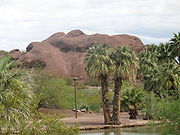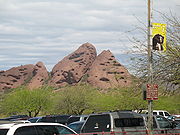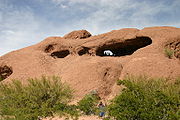
Papago Park
Encyclopedia

Urban park
An urban park, is also known as a municipal park or a public park, public open space or municipal gardens , is a park in cities and other incorporated places to offer recreation and green space to residents of, and visitors to, the municipality...
of the cities of Phoenix
Phoenix, Arizona
Phoenix is the capital, and largest city, of the U.S. state of Arizona, as well as the sixth most populated city in the United States. Phoenix is home to 1,445,632 people according to the official 2010 U.S. Census Bureau data...
and Tempe, Arizona
Tempe, Arizona
Tempe is a city in Maricopa County, Arizona, USA, with the Census Bureau reporting a 2010 population of 161,719. The city is named after the Vale of Tempe in Greece. Tempe is located in the East Valley section of metropolitan Phoenix; it is bordered by Phoenix and Guadalupe on the west, Scottsdale...
, USA. It has been designated as a Phoenix Point of Pride
Phoenix Points of Pride
The Phoenix Points of Pride are 33 landmarks and attractions within the Phoenix, Arizona, city limits that are claimed to represent the best features of the city for both residents and visitors...
.
Description

Desert
A desert is a landscape or region that receives an extremely low amount of precipitation, less than enough to support growth of most plants. Most deserts have an average annual precipitation of less than...
park covering some 490 hectares (1200 acre
Acre
The acre is a unit of area in a number of different systems, including the imperial and U.S. customary systems. The most commonly used acres today are the international acre and, in the United States, the survey acre. The most common use of the acre is to measure tracts of land.The acre is related...
s) in its Phoenix extent, and some 140 hectares (296 acre
Acre
The acre is a unit of area in a number of different systems, including the imperial and U.S. customary systems. The most commonly used acres today are the international acre and, in the United States, the survey acre. The most common use of the acre is to measure tracts of land.The acre is related...
s) in its Tempe extent (the latter is also referred to specifically as Tempe Papago Park). The park is surrounded by the cities of Phoenix, Tempe, and Scottsdale.
Papago Park is notable for its many distinctive geological formations and its wide variety of typical desert plants, including the giant saguaro cactus. The park also features the Desert Botanical Garden
Desert Botanical Garden
The Desert Botanical Garden is a botanical garden located within Papago Park in Phoenix, Arizona, USA. Founded by the Arizona Cactus and Native Flora Society in 1937 and established at this site in 1939, the garden now has...
, a large zoo (the Phoenix Zoo
Phoenix Zoo
The Phoenix Zoo opened in 1962 and is the largest non-profit zoo in the United States. Located in Phoenix, Arizona, the zoo was founded by Robert Maytag, a member of the Maytag family, and operates on of land in the Papago Park area of Phoenix. It has been designated as a Phoenix Point of...
), picnic areas, several small lakes, hiking
Hiking
Hiking is an outdoor activity which consists of walking in natural environments, often in mountainous or other scenic terrain. People often hike on hiking trails. It is such a popular activity that there are numerous hiking organizations worldwide. The health benefits of different types of hiking...
trails, bicycle paths, a fire museum, and Hunt's Tomb
Hunt's Tomb
Hunt's Tomb is the tomb of the late George W. P. Hunt, who was Arizona's first governor, and served a record seven terms. It is a small white pyramid behind a fence at the top of a hill within Papago Park, a municipal park in Phoenix, Arizona....
, the pyramidal tomb of Arizona's
Arizona
Arizona ; is a state located in the southwestern region of the United States. It is also part of the western United States and the mountain west. The capital and largest city is Phoenix...
first governor, George W. P. Hunt
George W.P. Hunt
George Wylie Paul Hunt was an American politician and businessman. He was the first Governor of Arizona, serving a total of seven terms, along with President of the convention that wrote Arizona's constitution. In addition, Hunt served in both houses of the Arizona Territorial Legislature and was...
. Tempe Papago Park includes baseball
Baseball
Baseball is a bat-and-ball sport played between two teams of nine players each. The aim is to score runs by hitting a thrown ball with a bat and touching a series of four bases arranged at the corners of a ninety-foot diamond...
and softball
Softball
Softball is a bat-and-ball sport played between two teams of 10 to 14 players. It is a direct descendant of baseball although there are some key differences: softballs are larger than baseballs, and the pitches are thrown underhand rather than overhand...
fields, picnic ramada
Ramada
Ramada is a hotel chain owned and operated by Wyndham Worldwide.- History :The lodging chain was founded in 1953 by longtime Chicago restaurateur Marion W...
s, a small lake, and other features. Rolling Hills Golf Course is within the park between its Phoenix and Tempe extremities.
History

Sandstone
Sandstone is a sedimentary rock composed mainly of sand-sized minerals or rock grains.Most sandstone is composed of quartz and/or feldspar because these are the most common minerals in the Earth's crust. Like sand, sandstone may be any colour, but the most common colours are tan, brown, yellow,...
geological formations of Papago Park were formed some 6-15 million years ago. One such formation, Hole-in-the-Rock
Hole-in-the-Rock (Papago Park)
Hole-in-the-Rock is a natural geological formation in Papago Park, a municipal park of Phoenix and Tempe, Arizona.-Description:Hole-in-the-Rock is a series of openings eroded in a small hill composed of bare red arkosic conglomerate sandstone...
, is a major landmark, thanks to the openings (tafoni
Tafoni
Tafoni are small cave-like features found in granular rock such as sandstone, with rounded entrances and smooth concave walls. They often occur in groups that can riddle a hillside, cliff, or other rock formation. They can be found in all climate types, but are most abundant in intertidal areas...
) eroded in the formation over time. There is some evidence that the Hohokam
Hohokam
Hohokam is one of the four major prehistoric archaeological Oasisamerica traditions of what is now the American Southwest. Many local residents put the accent on the first syllable . Variant spellings in current, official usage include Hobokam, Huhugam and Huhukam...
—a now-extinct aboriginal tribe that once lived in the Phoenix area—used the openings and sunlight
Sunlight
Sunlight, in the broad sense, is the total frequency spectrum of electromagnetic radiation given off by the Sun. On Earth, sunlight is filtered through the Earth's atmosphere, and solar radiation is obvious as daylight when the Sun is above the horizon.When the direct solar radiation is not blocked...
to track the solstice
Solstice
A solstice is an astronomical event that happens twice each year when the Sun's apparent position in the sky, as viewed from Earth, reaches its northernmost or southernmost extremes...
s.
There are also some signs of Precambrian
Precambrian
The Precambrian is the name which describes the large span of time in Earth's history before the current Phanerozoic Eon, and is a Supereon divided into several eons of the geologic time scale...
granite
Granite
Granite is a common and widely occurring type of intrusive, felsic, igneous rock. Granite usually has a medium- to coarse-grained texture. Occasionally some individual crystals are larger than the groundmass, in which case the texture is known as porphyritic. A granitic rock with a porphyritic...
in the park. The bedrock
Bedrock
In stratigraphy, bedrock is the native consolidated rock underlying the surface of a terrestrial planet, usually the Earth. Above the bedrock is usually an area of broken and weathered unconsolidated rock in the basal subsoil...
is concealed by only a thin layer of topsoil
Topsoil
Topsoil is the upper, outermost layer of soil, usually the top to . It has the highest concentration of organic matter and microorganisms and is where most of the Earth's biological soil activity occurs.-Importance:...
.
Papago Park was designated a reservation for the local Maricopa and Pima
Pima
The Pima are a group of American Indians living in an area consisting of what is now central and southern Arizona. The long name, "Akimel O'odham", means "river people". They are closely related to the Tohono O'odham and the Hia C-ed O'odham...
tribes of aboriginal Americans
Native Americans in the United States
Native Americans in the United States are the indigenous peoples in North America within the boundaries of the present-day continental United States, parts of Alaska, and the island state of Hawaii. They are composed of numerous, distinct tribes, states, and ethnic groups, many of which survive as...
in 1879. It became the Papago-Saguaro National Monument in 1914, but this status was recalled by Congress
United States Congress
The United States Congress is the bicameral legislature of the federal government of the United States, consisting of the Senate and the House of Representatives. The Congress meets in the United States Capitol in Washington, D.C....
, April 7, 1930, because the area was not considered suitable for a national monument. It was divided amongst the state of Arizona, the city of Tempe and the Water Users Association, later known as the Salt River Project
Salt River Project
The Salt River Project is the umbrella name for two separate entities: the Salt River Project Agricultural Improvement and Power District, an agency of the state of Arizona that serves as an electrical utility for the Phoenix metropolitan area, and the Salt River Valley Water Users' Association, a...
. Federal Government reserved all oil, coal or other mineral rights. During World War II
World War II
World War II, or the Second World War , was a global conflict lasting from 1939 to 1945, involving most of the world's nations—including all of the great powers—eventually forming two opposing military alliances: the Allies and the Axis...
, the park housed a POW
Camp Papago Park
Camp Papago Park was a prisoner of war facility located in Papago Park in the eastern part of Phoenix, Arizona. It consisted of five compounds, four for enlisted men and one for officers...
camp and contained as many as 3,100 prisoners from 1942 to 1944. It was also the site of the largest mass escape from any United States prison camp in World War II. The Great Papago Escape occurred on December 23, 1944 when 25 prisoners, including German U-boat commander Jürgen Wattenberg
Jürgen Wattenberg
Jürgen Wattenberg was a German naval officer and U-boat commander during the Second World War. In a successful career spanning just under a year, he sank 14 ships, a total of 82,027 gross registered tons ....
, escaped the camp using a 178-foot tunnel and made their way to the Arizona desert. Many prisoners quickly realized that they knew nothing about the landscape or climate and turned themselves back in. Wattenberg was the last to be captured, on January 28, 1945. After the war it served as a VA hospital from 1947 to 1951, then an Army Reserve
United States Army Reserve
The United States Army Reserve is the federal reserve force of the United States Army. Together, the Army Reserve and the Army National Guard constitute the reserve components of the United States Army....
facility. The state owned portion of the park was sold to the city of Phoenix on February 25, 1959. A portion of the Tempe park was conveyed to that city in 1935, and a parcel within that portion was conveyed to the Salt River Project
Salt River Project
The Salt River Project is the umbrella name for two separate entities: the Salt River Project Agricultural Improvement and Power District, an agency of the state of Arizona that serves as an electrical utility for the Phoenix metropolitan area, and the Salt River Valley Water Users' Association, a...
in 1955. An 18-hole championship golf course was built by the city of Phoenix and completed in 1963
The park was also the finish line in the fourth season of The Amazing Race
The Amazing Race
The Amazing Race is a reality television game show in which teams of two people, who have some form of a preexisting personal relationship, race around the world in competition with other teams...
.
Papago Ponds
The Ponds have a surface area of 6 acre (2.4 ha) with an average depth of 8 ft (2.4 m), the elevation of the area is 1100 ft (335.3 m).Fish Species
- Rainbow TroutRainbow troutThe rainbow trout is a species of salmonid native to tributaries of the Pacific Ocean in Asia and North America. The steelhead is a sea run rainbow trout usually returning to freshwater to spawn after 2 to 3 years at sea. In other words, rainbow trout and steelhead trout are the same species....
- Largemouth BassLargemouth bassThe largemouth bass is a species of black bass in the sunfish family native to North America . It is also known as widemouth bass, bigmouth, black bass, bucketmouth, Potter's fish, Florida bass, Florida largemouth, green bass, green trout, linesides, Oswego bass, southern largemouth...
- SunfishCentrarchidaeThe sunfishes are a family of freshwater ray-finned fish belonging to the order Perciformes. The type genus is Centrarchus . The family's 27 species includes many fishes familiar to North Americans, including the rock bass, largemouth bass, bluegill, pumpkinseed, and crappies...
- Catfish (Channel)Channel catfishChannel catfish, Ictalurus punctatus, is North America's most numerous catfish species. It is the official fish of Missouri, Iowa, Nebraska, Kansas, and Tennessee, and is informally referred to as a "channel cat". In the United States they are the most fished catfish species with approximately 8...
- TilapiaTilapiaTilapia , is the common name for nearly a hundred species of cichlid fish from the tilapiine cichlid tribe. Tilapia inhabit a variety of fresh water habitats, including shallow streams, ponds, rivers and lakes. Historically, they have been of major importance in artisan fishing in Africa and the...
- CarpCarpCarp are various species of oily freshwater fish of the family Cyprinidae, a very large group of fish native to Europe and Asia. The cypriniformes are traditionally grouped with the Characiformes, Siluriformes and Gymnotiformes to create the superorder Ostariophysi, since these groups have certain...
External links
- Papago Park Facts - provided by the City of Phoenix
- Tempe Papago Park provided by the City of Tempe
- Papago Park : a history of Hole-in-the-Rock from 1848-1995 prepared by Jason H. Gart ; foreword by Roger Lidman
- Arizona Fishing Locations Map
- Arizona Boating Locations Facilities Map
- Papago Park Photos - Photos of Papago Park landscape, wildlife and surrounding area.

